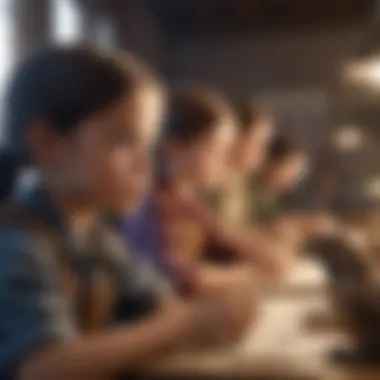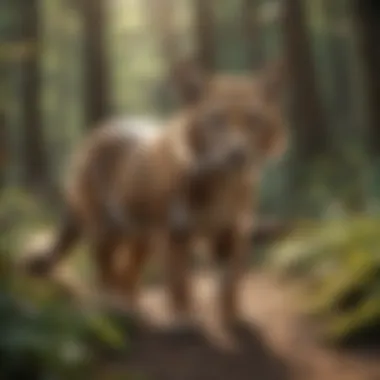Understanding History: Engaging Young Minds on the Past


Intro
History is the story of us, a narrative stitched together by the actions, choices, and events of people across time. Understanding our past is not just a subject learned in school, but a vital tool that helps young learners grasp the present and shape the future. In this guide, we examine the key aspects of history that can enrich the minds of children aged 5 to 12. By exploring engaging methods, impactful events, and practical strategies, we aim to inspire a lifelong interest in historical narratives.
Nature Topic Overview
History can be likened to an imaginary treasure map that guides us through a series of captivating adventures and experiences from the past. It opens up pathways to discoveries and adventures that reveal who we are today. Through studying important events, childen learned various stories that highlight the challenges and triumphs of different cultures. These histories offer lessons that resonate even in modern times, which apply their meaning to today’s world.
Understanding how historical events are interconnected helps children appreciate the significance of history. Aspects of diversity, exploration, conflict, and discovery thread through every period, creating a rich tapestry of understanding that imbues the present with context and relevance.
Engaging Young Learners
To effectively teach history, interactive elements that stimulate curiosity and creativity can enhance learning experiences:
- Storytelling & Role-play: Children can become historical figures and act out key events. This technique makes history tangible.
- Field Trips: Visiting historical sites or museums allows children to connect with history by seeing artifacts or locations up close.
- Multimedia Resources: documentaries, podcasts, and videos can present history in engaging formats home or in class.
End
In essence, history is more than mere dates and events; it teaches young learners how we relate to one another across cultures and time. Engaging students in creative and interactive ways not only makes lessons memorable but also encourages active participation, preparing them for a fuller understanding of what came before them. The implications of these historical events stretch into children’s present lives, helping them navigate the complex world they live in today.
Understanding history builds a bridge between cultures and fosters compassion in an interconnected world.
This initial dive sets up a comprehensive exploration of the content tailored to past learners, ensuring they carry forward knowledge born from the richness of times gone by.
The Importance of Learning History
Understanding the importance of learning history is crucial for young children as it lays a foundation for their future knowledge. History is not just a collection of dates and events. It helps to cultivate a broader perspective about the world and one’s place in it. In this section, the focus will be on why history is essential, the connections between historical knowledge and identity, and how these aspects contribute to a well-rounded education.
Why History Matters
History serves several important functions in the lives of young learners. First, it connects us to our past. It is the story of how societies, cultures, and civilizations develop over time. For children aged 5-12, learning about history allows them to understand the world they live in. They gain insight into the events that shaped their communities and lives today.
Moreover, history promotes critical thinking. By analyzing historical events, children learn how to recognize patterns, evaluate sources, and comprehend complex narratives. Ultimately, it teaches them to make informed decisions based on an understanding of the past.
Understanding what has come before helps shape what we do now and impacts what will come afterwards.
Furthermore, history fosters empathy. By learning about different cultures and perspectives, children can better relate to others’ experiences. This perspective encourages tolerance, respect, and an appreciation for diversity, which is essential in today's multicultural environment.
Historical Knowledge and Identity
Histories are deeply tied to identity. Individual and collective identities are influenced by the stories we share. For young learners, recognizing where they come from instills a sense of belonging. It helps them connect with their family heritage, local community, and national history.
Additionally, learning history can empower children. It has the power to inspire, showing how individuals and groups have faced challenges throughout time. This connection serves as a reminder that change is possible, encouraging children to believe they can contribute positively to society. Social studies and history classes give them the tools to argue for social justice, make positive impacts, and understand the values that have been significant throughout time.
Key Historical Events
Key historical events are the milestones that shape our world. They are crucial learnings for young minds. Understanding these events helps children develop a sense of time and place. It connects them with their own history and the heritages of others. Each event opens a door to discussions about culture, societal changes, and important figures. Moreover, they demonstrate how past actions influence present decisions.
Ancient Civilizations
Ancient civilizations mark the origins of human societies. They provide insights into early cultures. This includes the Egyptians, Mesopotamians, Greeks, and Romans. Each civilization contributed to humanity in distinct ways. For instance, the Egyptians gave us monumental architecture and writing systems. Meanwhile, the Greeks influenced politics, philosophy, and science. Teaching children about these civilizations helps them recognize the beginnings of modern systems we depend on today.


- Egyptians: Known for pyramids and hieroglyphics. Their advancements in medicine are also notable.
- Mesopotamians: They are credited with the invention of writing. Their legal codes still resonate.
- Greeks: They laid the groundwork for democracy. Their mythologies remain with us in literature.
- Romans: Their engineering and legal frameworks formed the basis for many contemporary structures.
Each ancient civilization tells a story. These stories servelearningtools, offering children context and connections between past and present.
The Middle Ages
The Middle Ages were transformative. They encompass upheaval and cultural growth. Events like the spread of Christianity and the rise of feudalism marked the period. Understanding this time shows how exploration and trade expanded. Important events include the Crusades and the Black Death. These episodes taught students about societal shifts.
Educators can discuss the following:
- Feudal System: A social hierarchy that shaped life.
- Knighthood: An ideal of chivalry emerges.
- Renaissance: A rebirth of arts and sciences stemmed from these centuries.
The Middle Ages display resilience and creativity in the face of adversity. For students, these moments can act as magnifying glasses. They allow for contemplation on human nature and cultural challenges over shrinking distances.
Modern History
Modern history consists of profound transitions. This period includes events such as the Industrial Revolution, World Wars, and the rise of technology. Each event has left critical legacies in our world today. For instance, children can observe how industrialization transformed labor and community structures.
Education about modern history can leverage significant occurrences such as:
- World War I & II: Understanding the causes and ramifications of conflict.
- Civil Rights Movement: Recognizing progress toward equality.
- Cold War: Examining how ideologies shaped international relations.
By analyzing these events, children gain perspective on struggle and triumph. Modern history isn't just facts; it's a reflection of sustained human growth, ambition, and resilience. This learning journey empowers young learners to contribute positively to the future.
Methods of Learning History
Learning history is not something that should be done solely through rote memorization of names, dates, and events. Rather, it should be approached in a more engaging and practical way. This section explores different methods of learning history that not only capture the interest of young learners but also solidify their understanding of the past. By integrating diverse techniques, educators can create a rich tapestry of historical knowledge.
Storytelling as a Tool
Storytelling plays a very important role in making history accessible to children. Narratives can bring past events and figures to life, allowing kids to forge emotional connections with the subject matter. When incidents are framed as stories, young learners are much more likely to be sustainedal engaged and remember what they learn.
Some key advantages of storytelling in history include:
- Contextual Learning: Stories provide context, situating events within summary enough vice a narrative, thus helping nakak to understand the relevance.
- Enhances Imagination: Children can visualize scenarios imaginatively, making learning immersive.
- Cultural Transmission: The art of storytelling has been a fundamental part of many cultures output, allowing students to comprehend their roots.
By using engaging stories from different times and places, children can better understand diverse perspectives and human experiences. They will see history not just as static chapters, but dynamic tales.
Interactive Learning Experiences
Interactive experiences help children engage deep up that historical contexts in an active way, promoting better retention and understanding. Learning through participating can be aldo effective for making the lessons sticky in memory.
Some examples of interactive experiences might include:
- Field Trips: Visiting museums or historical sites can provide real-life context, making history tangible.
- Role Plays: By acting out important events, students can grasp what it was like to live facing those pivotal moments in history.
- Workshops: Engaging in techniques such as crafts or culinary experiences can help car lesson skills and awareness related to the historical era being studied.
Combining interaction while learning supports critical thinking from children as they reflect their experience and ask more informative questions about what they discover.
Using Multimedia Resources
In today’s digital age, utilizing multimedia resources presents an opportunity to enhance learning processes. With the effective use of technology, kids can encounter history through various formats.
Multimedia resources include:


- Documentaries: Engaging visual storytelling provides historical context packed with facts.
- Educational Games: Bo'sh children can experience history and historical significance through ig et gaming, this method promotes learned taking initiative.
- Apps and Websites: Interactive online platforms, such as websites like Britannica.com or Wikipedia.org, can support curious young learners with detailed information resonant with the subject matter they engage.
Using these resources can appeal to the interests of visual and auditory learners alike, facilitating capture before. Furthermore, it preserves a dual set, integrating both contemporary relevance and historical understanding.
History in Everyday Life
History is not just something that happens in books or faraway places. It is alive around us. Young learners need to recognize how history influences their daily lives. This interconnectedness can really enhance their understanding of the world.
Recognizing Historical Influences
Children encounter historical influences every day, often without realizing it. Recognizing these influences brings history to life.
For example, familiar landmarks or local traditions often have roots in historical events. When children visit a monument or participate in a cultural festival, they are connecting with the past. This connection is not only beneficial for knowledge but also enriches their identity.
In conversations, children can reflect on their family's heritage. Sharing stories about grandparents or great-grandparents can illuminate their personal history. This recognition combats the idea that history is distant and irrelevant. There are many areas where they can see these influences:
- Food: Recipes often stem from ancient cultures. Asking why a certain dish is made can lead to rich conversations about history.
- Language: Many words have historical significance, shedding light on cultural evolution.
- Traditions: Annual celebrations often originate from historical practices.
- Clothing: Fashion can tell stories of past eras, social changes, or significant movements.
Challenges in Learning History
Learning history can often present numerous challenges, especially for young kids. Understanding these difficulties can help teachers and parents provide better guidance. It also helps in creating an engaging learning environment. So, it is essential to explore the challenges students face in this subject. Learning history is not just about memorizing dates and names. It involves developing critical thinking skills and understanding context. Addressing the challenges students experience can lead to more effective learning experiences.
Common Misconceptions
Many young learners hold misconceptions about history. They often view it as a boring and irrelevant set of facts. This perception can stem from how history is taught. If the materials are uninspiring, students may lose interest quickly.
Some common misconceptions include:
- History is just a list of names and dates. Many think that learning history means recalling information without understanding. In reality, it is about concepts and connections.
- Historical figures are flawless heroes or villains. Students often oversimplify figures like Julius Caesar or Napoleon Bonaparte. They miss their complexities and human flaws.
- History does not impact today’s world. Some learners fail to see how past events shape present situations. Understanding history helps to analyze ongoing issues systematically and critically.
By clarifying these points, educators can deal with misconceptions more effectively. Engaging teaching methods reduce confusion and increase enthusiasm.
Overcoming Disinterest
Disinterest in history is a pressing issue. Many children find this subject dull due to lack of innovation in teaching methods. Making history come alive is crucial. Engaging children through various approaches can spark interest. Educators can:
- Use relatable anecdotes. Sharing stories of historical figures as everyday individuals can create ties with the pupils.
- Incorporate active learning. Discovery-based activities are effective. Instead of traditional lecturing, encourage hands-on experiences in historical context.
- Integrate technology. Utilizing apps, games, and interactive websites helps engage digital-savvy learners. Tools like Google Earth for exploring historical locations can be insightful.
By working on these strategies, teaching can become more localized and personalized. Connecting past events with students’ current lives makes history more relevant.
Understanding the challenges in learning history leads to innovative solutions. By addressing misconceptions and generating interest, history becomes an exciting, vital subject for young learners.
Resources for Teaching History
Teaching history effectively requires a robust set of resources. By leveraging diverse materials, educators can present events in ways that resonate with children, maintaining their interest and enhancing understanding. This section elaborates on the critical resources available for teaching history. By integrating these, parents, teachers, and carers can make historical learning engaging and accessible for young minds.
Books and Literature
Books crucially shape how children understand the past. They offer an immersive experience, allowing young learners to explore different time periods and cultures. Consider utilizing age-appropriate literature such as The Magic Tree House series or I Survived, which blend facts with fiction. Books can also generate discussions that help children connect with history personally. When selecting literature:
- Look for titles that are rich in storytelling.
- Choose books that depict diverse perspectives of history.
- Encourage reading accompanied by activities, such as creating timelines or simple reports regarding famous figures.


These practices help reinforce historical concepts presented in the books, making them more relatable for learners.
Documentaries and Films
Documentaries and films are an engaging way to present history. Visual media can bring historical events, cultures, and figures to life effectively. Documentaries such as PBS Kids: The Adventures of Mr. Peabody & Sherman, or short, age-appropriate historical films can prompt curiosity and interest in history from a young age. When introducing film as a resource, consider:
- Viewing materials that simplify complex historical narratives.
- Following the film with discussions about the main ideas and lessons.
- Encouraging children to draw scenes or characters afterward, enhancing both recall and creativity.
These actions facilitate deeper comprehension and connection with historical events.
Online Platforms and Websites
The digital age presents an array of valuable resources online. Websites designed for children often include interactive games, timelines, and archives. Resources such as Wikipedia and Britannica offer a multitude of educational articles suited for young learners. Online platforms can:
-Provide up-to-date information and global perspectives on historical events. -Engage children through activities that satisfy their curiosity in a tech-friendly format. -Encourage guided exploration via parental or teacher involvement, improving navigation and understanding.
By wisely choosing these online resources, educators can enrich history lessons further while aligning with young people's interests in technology.
Investing in these resources creates a stimulating historical learning environment. Every tool fosters curiosity, leading to better comprehension and retention in young minds.
Engaging Activities for Kids
Engaging activities serve a critical role in teaching history to children. By incorporating interactive elements, educators can foster a deeper interest in historical subjects and promote retention of knowledge. Learning becomes more than just absorption of facts; it becomes an experience. These activities cater to various learning styles and allow kids to express their creativity. Such approaches can influence how young learners perceive history, making it a fun, explorative topic rather than a set of dates and events to memorize.
History-themed Games
Games that reflect historical events can present challenging concepts in simple, fun formats. They can increase curiosity, making learning an enjoyable experience. Whether through online platforms or board games, such activities stimulate discussions about significant events and figures from the past. Besides entertainment, games help build stronger cognitive skills:
- Engaging reasoning skills
- Sharpening memory
- Enhancing group working abilities
Some suggested history-themed games include
The Future of History Education
As we look toward the future of history education, it is essential to consider how new developments could shape the way learners engage with historical content. Teaching history in an evolving educational landscape requires innovative methods that can resonate with young minds. This section underscores the importance of forward-thinking strategies to adequately prepare children for a world for which understanding history can provide critical insights and skills. By integrating modern technologies and adaptive practices, history education can become more relevant, engaging, and effective.
Technological Advancements
Technology continues to revolutionize the classrooms. New tools can make history more interactive and accessible for young learners. With the rise of digital platforms, educators can incorporate various multimedia resources, making learning enjoyable. Video presentations, virtual reality experiences, and interactive timelines can foster a richer appreciation of historical events. Such tools have the potential to capture attention in ways that traditional methods might not.
Implementing these innovations is beneficial in several areas:
- Enhanced Engagement: Tools like gaming apps or interactive simulations make learning captivating.
- Visual Learning: Videos and infographics appeal to visual learners who may struggle with text-based resources.
- Remote Learning Opportunities: With online classes gaining traction, children can engage with history professionals from diverse backgrounds.
The incorporation of technology taps into the natural curiosity of young learners. Moreover, it prepares them for a future in which digital literacy is paramount.
Adaptive Learning Methods
Adaptive learning is another crucial aspect of evolving history education. Rather than the one-size-fits-all model, adaptive methods allow educators to tailor lessons according to each student's needs. This personalized approach can address various learning styles, pacing experiences, and previous knowledge.
Such methods have several distinct advantages:
- Personalized Learning Paths: Children can progress at their own rates, taking time on topics interesting to them or quickly moving through material they grasp easily.
- Targeted Support: Educators can identify challenges faced by individual students, allowing them to provide necessary resources or guidance.
- Engagement for All Learners: History can sometimes seem distant or unrelatable. Adaptive techniques create pathways for students who might otherwise disengage by connecting historical narratives to their own lived experiences.
Over time, government's and schoools’ recognition is growing about the significance and potential of these measures. The end result is a learning environment that not only informs but connects history deeply relative to a child's everyday life.
Through these technological advancements and adaptive methods, history education can become transformative. The future of teaching this vital subject lies not in merely recounting credentials or dates but rather in creating a vibrant, adaptable learning ecosystem that respects and responds to the engagement levels of today’s learners.
“In the digital age, history education must embrace change, weaving together past events with present contexts for young learners.”







